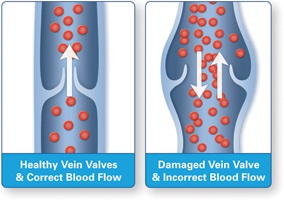Overview Varicose Veins & Chronic Venous Insufficiency (CVI)
More than 30 million Americans suffer from varicose veins and the more serious form of venous disease called Chronic Venous Insufficiency (CVI), yet only 1.9 million seek treatment each year.1,2,3 If the disease is left untreated, varicose veins can progress to become CVI with symptoms that worsen over time. Fortunately, diagnosing and treating this disease early can halt its progression.
Understanding the Condition
What are Varicose Veins?
Varicose veins are enlarged veins that can be blue, red or flesh colored. They are often raised above the skin on legs and look like twisted, bulging cords. They can also be associated with pain, aches, heaviness, restless legs, or burning and itching of the skin.
What is Chronic Venous Insufficiency (CVI)?
Chronic Venous Insufficiency (CVI) is a progressive medical condition that may worsen over time. As varicose veins progress to become CVI, other painful symptoms like leg swelling, skin damage and ulcers may occur.4,5There are a number of factors that contribute to varicose veins and CVI, including pregnancy and heredity.4
Minimally Invasive Treatments
Today, there are a number of minimally invasive treatment options that are covered by many insurance plans. While treatments like compression stockings are often first prescribed to manage symptoms, there are a variety of treatments that may actually treat the diseased veins that cause varicose veins, improve your quality of life and potentially halt the progression of CVI.
Endovenous Thermal Ablation
Endovenous thermal ablation is a minimally invasive treatment that involves the insertion of a thin, flexible tube called a catheter into a diseased vein and uses heat to seal it shut. Blood that would normally return toward the heart through these veins will then travel through other veins instead. Over time the treated vein shrinks and is absorbed by the body. Compared with surgical options like vein stripping, endovenous thermal ablation results in less pain and quicker average recovery time.6
Venefit™ Targeted Endovenous Therapy
We proudly offer the Venefit™ procedure, formerly known as the VNUS Closure™ procedure, for the treatment of varicose veins and CVI. The Venefit™ procedure is a minimally invasive segmental ablation treatment that utilizes radiofrequency (RF) energy to provide an even and uniform heat to contract the collagen in the vein walls, causing them to collapse and seal. Once the diseased vein is closed, blood will re-route itself to other healthy veins.
The Venefit™ procedure allows for a quick, comfortable recovery and a return to everyday activities for the average patient, while also improving the appearance of varicose veins.6,7
The Venefit™ procedure has been proven in clinical studies to have excellent long term effectiveness, with less pain and bruising than endovenous laser*.7
*A comparison of the patient experience between those treated with the Venefit ™procedure, using the Covidien ClosureFast™ Endovenous Radiofrequency Ablation (RFA) Catheter, and those treated with 980nm laser ablation.
Venefit and ClosureFast are trademarks of a Covidien company.


